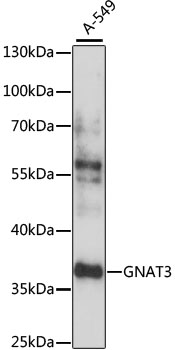Anti-GNAT3 Antibody (CAB15982)
- SKU:
- CAB15982
- Product type:
- Antibody
- Reactivity:
- Human
- Reactivity:
- Mouse
- Host Species:
- Rabbit
- Isotype:
- IgG
- Antibody Type:
- Polyclonal Antibody
- Research Area:
- Cell Biology
Frequently bought together:
Description
| 抗体名: | Anti-GNAT3 Antibody |
| 抗体コード: | CAB15982 |
| 抗体サイズ: | 20uL, 50uL, 100uL |
| 申し込み: | WB IF |
| 反応性: | Human, Mouse, |
| 宿主種: | Rabbit |
| 免疫原: | Recombinant fusion protein containing a sequence corresponding to amino acids 60-130 of human GNAT3 (NP_001095856.1). |
| 申し込み: | WB IF |
| 推奨希釈: | WB 1:500 - 1:2000 IF 1:50 - 1:200 |
| 反応性: | Human, Mouse, |
| ポジティブサンプル: | A-549 |
| 免疫原: | Recombinant fusion protein containing a sequence corresponding to amino acids 60-130 of human GNAT3 (NP_001095856.1). |
| 精製方法: | Affinity purification |
| ストレージバッファ: | Store at -20'C. Avoid freeze / thaw cycles. Buffer: PBS with 0.02% sodium azide, 50% glycerol, pH7.3. |
| アイソタイプ: | IgG |
| 順序: | GYSE QECM EFKA VIYS NTLQ SILA IVKA MTTL GIDY VNPR SAED QRQL YAMA NTLE DGGM TPQL AEVI KRL |
| 遺伝子ID: | 346562 |
| Uniprot: | A8MTJ3 |
| セルラーロケーション: | Cytoplasm |
| 計算された分子量: | 40kDa |
| 観察された分子量: | 37kDa |
| 同義語: | GNAT3, GDCA |
| バックグラウンド: | Sweet, bitter, and umami tastes are transmitted from taste receptors by a specific guanine nucleotide binding protein. The protein encoded by this gene is the alpha subunit of this heterotrimeric G protein, which is found not only in the oral epithelium but also in gut tissues. Variations in this gene have been linked to metabolic syndrome. |
| UniProt Protein Function: | G-alpha t3: Guanine nucleotide-binding protein (G protein) alpha subunit playing a prominent role in bitter and sweet taste transduction as well as in umami (monosodium glutamate, monopotassium glutamate, and inosine monophosphate) taste transduction. Transduction by this alpha subunit involves coupling of specific cell-surface receptors with a cGMP-phosphodiesterase; Activation of phosphodiesterase lowers intracellular levels of cAMP and cGMP which may open a cyclic nucleotide-suppressible cation channel leading to influx of calcium, ultimately leading to release of neurotransmitter. Indeed, denatonium and strychnine induce transient reduction in cAMP and cGMP in taste tissue, whereas this decrease is inhibited by GNAT3 antibody. Gustducin heterotrimer transduces response to bitter and sweet compounds via regulation of phosphodiesterase for alpha subunit, as well as via activation of phospholipase C for beta and gamma subunits, with ultimate increase inositol trisphosphate and increase of intracellular Calcium. GNAT3 can functionally couple to taste receptors to transmit intracellular signal: receptor heterodimer TAS1R2/TAS1R3 senses sweetness and TAS1R1/TAS1R3 transduces umami taste, whereas the T2R family GPCRs act as bitter sensors. Functions also as lumenal sugar sensors in the gut to control the expression of the Na+-glucose transporter SGLT1 in response to dietaty sugar, as well as the secretion of Glucagon-like peptide- 1, GLP-1 and glucose-dependent insulinotropic polypeptide, GIP. Thus, may modulate the gut capacity to absorb sugars, with implications in malabsorption syndromes and diet-related disorders including diabetes and obesity. Belongs to the G-alpha family. G(i/o/t/z) subfamily. |
| UniProt Protein Details: | Protein type:G protein; G protein, heterotrimeric; G protein, heterotrimeric alpha G((i/o/t/z)) Chromosomal Location of Human Ortholog: 7q21.11 Cellular Component: acrosome; apical plasma membrane; axoneme; heterotrimeric G-protein complex; plasma membrane; protein complex Molecular Function:G-protein beta/gamma-subunit binding; G-protein-coupled receptor binding; GTP binding; GTPase activity; metal ion binding; signal transducer activity Biological Process: G-protein signaling, adenylate cyclase inhibiting pathway; G-protein signaling, coupled to cAMP nucleotide second messenger; metabolic process; protein folding; response to nicotine; sensory perception of bitter taste; sensory perception of sweet taste; sensory perception of umami taste |
| NCBI Summary: | Sweet, bitter, and umami tastes are transmitted from taste receptors by a specific guanine nucleotide binding protein. The protein encoded by this gene is the alpha subunit of this heterotrimeric G protein, which is found not only in the oral epithelium but also in gut tissues. Variations in this gene have been linked to metabolic syndrome. [provided by RefSeq, Dec 2015] |
| UniProt Code: | A8MTJ3 |
| NCBI GenInfo Identifier: | 156139155 |
| NCBI Gene ID: | 346562 |
| NCBI Accession: | NP_001095856.1 |
| UniProt Secondary Accession: | A8MTJ3,A4D1B2, A4D1B3, B9EJG5, |
| UniProt Related Accession: | A8MTJ3 |
| Molecular Weight: | |
| NCBI Full Name: | guanine nucleotide-binding protein G(t) subunit alpha-3 |
| NCBI Synonym Full Names: | G protein subunit alpha transducin 3 |
| NCBI Official Symbol: | GNAT3 |
| NCBI Official Synonym Symbols: | GDCA |
| NCBI Protein Information: | guanine nucleotide-binding protein G(t) subunit alpha-3 |
| UniProt Protein Name: | Guanine nucleotide-binding protein G(t) subunit alpha-3 |
| UniProt Synonym Protein Names: | Gustducin alpha-3 chain |
| UniProt Gene Name: | GNAT3 |
| UniProt Entry Name: | GNAT3_HUMAN |
View AllClose



